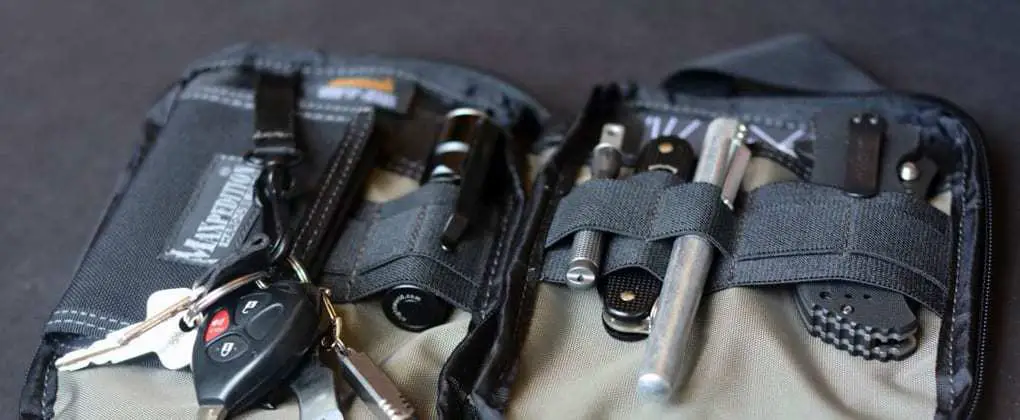We talked about in What is everyday carry (EDC)? that everyday carry refers to the items you carry on an everyday basis, like a firearm, knife, pen, wallet, keys, or anything else that’s essential to your daily life.
Many people limit their EDC to what can be physically carried on a person or in a small bag, but the concept of EDC can also be more broadly applied to preparedness items in general, extending to what can be stored in a vehicle or larger backpack.
We’ve separated EDC into three main tiers to help you (and us) better separate each layer and be much more intentional about what we carry, why we carry it and when we should carry it.

Tier 1: Primary EDC
Your Primary EDC is gear that fits in your pockets or is on your person. It’s readily accessible and mostly or entirely concealed.
Your Primary EDC can include:
- Concealed Firearm: If allowed and with proper training, a firearm can be a critical component of personal defense. In regards to carry types, there is a lot of debate, but I prefer concealed carry for its tactical advantages and how it fits in with the Gray Man Philosophy.
- Knife or multitool: Cutting, scraping, fixing, trimming, opening … the functions that a knife/multitool can provide are endless. Consider a deep-pocket carry clip or no clip at all if you live in an area where folks may find even a small pocket knife threatening
- Flashlight: It could easily become your most-used piece of gear, having light in the darkness can be invaluable. Keychain-sized lights can provide minimum weight and bulk while larger, handheld lights can give you maximum brightness
- Pen and paper: Carrying a pen and paper gives you the important ability to be able to write stuff down. Be sure to check out our in-depth article Five reasons you need to add a pen (and paper) to your EDC
- Identification and payment: Carried in a wallet or money clip, your identification and ability to pay for things is a much-needed part of your Primary EDC. Be sure to check out our in-depth, 3-part series “Carrying cash as part of your EDC“
- Escape and evasion tools: In the rare case of illegal restraint, you should be prepared to defeat the common types and methods used.
- Additional gear: Depending on where you’re going, having fire-making tools, first aid supplies, etc. can be a critical piece of your EDC
Your Primary EDC will look different depending on where you’re going, what you’re doing, who you are with, and what clothes you are wearing. Knowing your gear and being intentional about what you carry will allow your Primary EDC to work best for you.
Tier 2: Secondary EDC

Your Secondary EDC is gear that is carried in a separate bag, organizer, or container but is still with you as you go about day-to-day life. It can be carried in a backpack, briefcase, cargo pocket, or purse.
Your Secondary EDC can include:
- First Aid: Basic first aid, from band-aids to a tourniquet, can do everything from making your 2-year-old content to saving a life
- Back-up tools: A secondary knife or multi-tool gives you screwdrivers, scraping tools, maybe different blade steel or serration, etc.
- Food: Whether it’s nuts, a granola bar, or whatever non-perishable food item that you prefer, being able to fend off hunger is a critical piece of your EDC
- Basic survival gear: If you don’t carry it as part of your Primary EDC in certain situations, ensure you have the ability to; start a fire or the ability to keep warm in colder months (with a survival blanket)
- Cash: We’ve covered it in-depth before, but cash is still king and you have to ensure you have the ability to pay for things as it can keep you out of trouble
Your Secondary EDC is just that, secondary or supplemental to your Primary EDC. It can grow or diminish in size as your clothing, destination, activities, and people you’re with change.
Tier 3: Extended EDC

Your Extended EDC is sometimes called an operational bag, get-home bag, 72-hour bag, 3-day bag, etc., but can also be what you store in your car or even at home. Your Extended EDC encompasses any additional gear you own, regardless of where it’s stored.
There is no way to list everything that an Extended EDC can entail, but things that can come to mind:
- Get home bag: As we talked about above, having additional gear in your get home bag/3-day bag/operational bag to get you from where you are to where you need to be is a critical piece of your Extended EDC
- Gear kept on a nightstand: What do you have within arms reach when you are sleeping? You spend (hopefully) 6-8 hours asleep every day and whether it’s your Primary EDC that you dump in a valet tray, a high-lumen flashlight, a baseball bat, or your preference, what you are intentional about having next to you when you sleep is part of your Extended EDC
- Safe: Cash you keep at home, rifles, and other weapons
- Gear bin/closet/room: Whether kept in your basement in a plastic tub, any gear that is kept at your house (camping, survival, extra backpacks, or clothes) is all part of your Extended EDC
- Gear in your vehicle: No matter what you store in your car or truck for a “just in case” scenario, having additional items readily available is important in bad weather, emergencies, accidents, or just the small things that seem to come up in life
Extending the concept of everyday carry to these much broader areas of our lives can help us change the way we think about preparedness in general.
What do you think? As the everyday carry community and philosophy grows, do you think better defining it makes sense? What are we missing?

